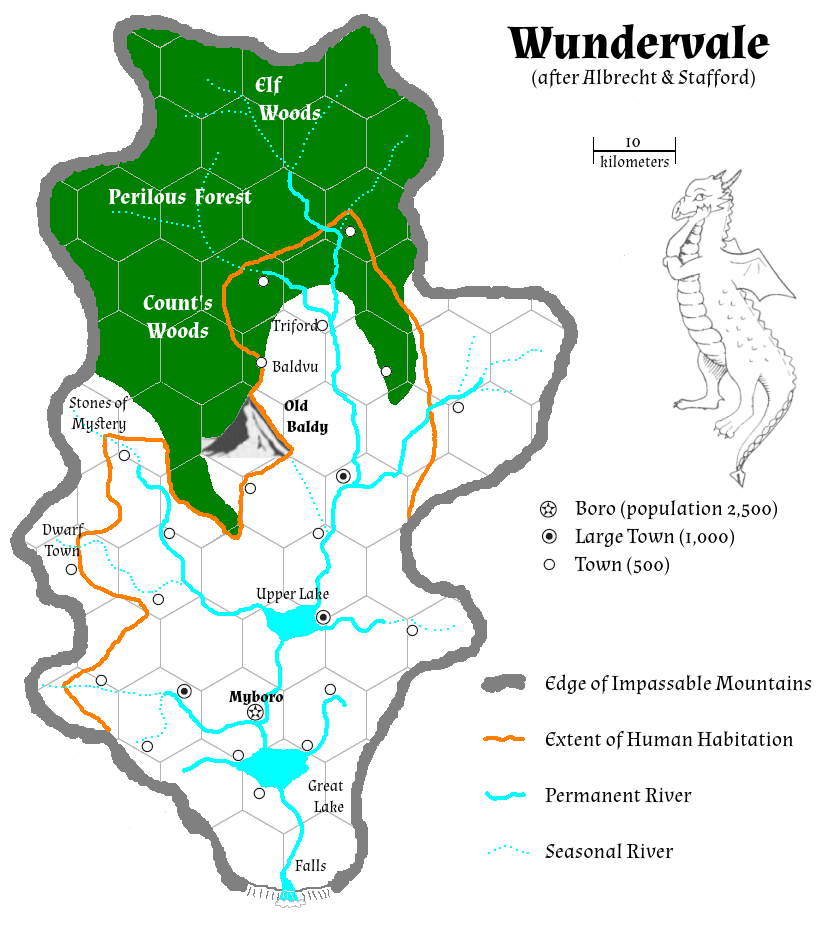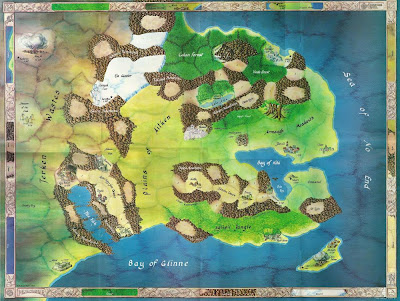Along with a set of rules, The Adventurer's Handbook offers a setting called Wundervale. The map provided in the book is rather unsightly, so I was compelled to create a less unsightly map that I present above. (The map in the book shows “Elf Wood's.”)
The first human settlers arrived in Wundervale “less than a century ago” and began the process of deforestation. According to the book:
About 50,000 people live in the populated regions.Nonhuman races also inhabit the valley, including elves, trolls, dwarves, and goblins. The book allows player characters of the races although some sections of the book suggest that human - nonhuman relations are strained or even violent.
Myboro is the largest settlement, numbering about 2,500 souls inside its walls. It is the county capital as well, and handsome staunch towers gird the wall to protect it. Its docks house a fleet of small, swift fishing boats. Is markets are the meeting places for the foreign merchants from beyond the valley and the local farmers and artisans. It is famous for its seven green-dyed cloths which cannot be duplicated outside this valley, and for the tiny carved wooden charms that bring luck in games of chance.
Three large towns serve as seasonal marketplaces for the smaller towns that surround Myboro. They are also centers of tax collection, grain storage, and so on. Wares not locally made in the towns can generally be found here, including imported cloth and specialized goods such as alchemist's equipment and astrologer's instruments.
Towns are the places where weekly peddlers' markets are held. A town will generally have a parish priest, a smith, a carpenter, a thatcher, and a leather worker. Noblemen of knight status will generally live in a town, or the town will have grown up around his manor. The average size is 600 residents.
Towns are surrounded by villages that are arranged to be about an hour's walk apart, dotting the countryside. These are small settlements of a few families, clustered about their barns and agricultural tools. Most people live in these settlements, about three-fifths of the total population. Town dwellers should also be counted as rural dwellers, which raises the total to about 85% rural population. Furthermore, most of the people within the larger settlements are also farmers in the fields about their their cities, so that almost 90% of the population is engaged in agricultural practices, or performs labor to support the farmers.
About 2% of the population is engaged in full-time religious work, so there are about 1,000 clerics or their equivalent in the valley. About 5% of the region is generally supported as a standing army, so this region provides about 2,500 soldiers and knights. Finally, the rest (3%) are aristocrats of varying ranks, totaling about 1,500 men, women, and children of noble birth.
In Myboro, there is the Taverna Athena, “a large, warm, comfortable, and entertaining place, populated by city folk, adventurers, scholars, magicians, and even members of the nonhuman races of Wundervale: dwarves, elves, and trolls.” At this tavern, “these ancient enemies of each other put aside their animosity and treat each other with respect and civility, if not friendship.” Evidently, goblins aren't welcome, perhaps because – for armor – goblins “favor Cuirboilli, especially that made from laminated layers of human skin.” If dwarves, trolls, and elves are tolerated in the Taverna Athena, then they must be tolerated in Myboro and, if they are tolerated in Myboro, they must be tolerated as they travel from their enclaves through human inhabited areas while en route to Myboro. Of course, there has to be a reason for them to travel to Myboro and associate with humans.
Dwarf Town is found on the western side of the valley. I suppose Dwarf Town is a colony of dwarves and not a human town with miniature buildings. Since the human habitation zone borders upon Dwarf Town, one supposes there is an understanding between the dwarves and humans in that area.
On the eastern side of the valley, there is a town outside of the human habitation zone. Is this a population center for nonhumans? Perhaps the original map erroneously excluded it from the human zone.
Since the valley is entirely surrounded by impassible mountains “save through the southern gap,” the 'foreign merchants' must travel through that gap. How they manage to traverse the waterfall or cliffs is not detailed.
Anyway, the book continues to describe Taverna Athena:
Taverna Athena is a special place, the center of information and activity in Myboro. It is part of a large complex that includes an inn, stables, and assorted shops...In a future book, or possibly in a magazine such as Different Worlds, we will tell the story of Taverna Athena, and the the mysterious noble, Kulmar, who...[description ends]The character Joleen spends time at Taverna Athena and describes it as “a place of philosophers and entertainers, and those who are neither but like to be with both.” Another feature of Myboro is a weapon shop “owned by and attended to be Rehsu, who gives good quality, fair prices, and loves to talk about past glories.”









